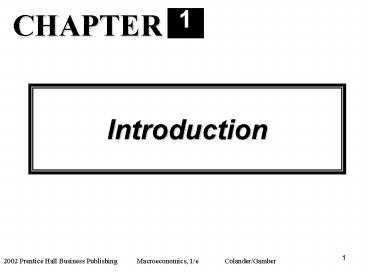Chapter 1 Introduction - PowerPoint PPT Presentation
1 / 26
Title:
Chapter 1 Introduction
Description:
No one knows what the actual natural rate of unemployment is. ... Supply-side policies affect aggregate supply (output) and have a long-run focus. 22 ... – PowerPoint PPT presentation
Number of Views:36
Avg rating:3.0/5.0
Title: Chapter 1 Introduction
1
Introduction
- 1
CHAPTER
2
Objectives you should be able to
- Define macroeconomics
- Identify the normative and feasible goals for a
macroeconomy - Describe the U.S. recent experience with these
goals - Identify intermediate goals (means to the end)
- Describe the kinds of policies that can impact
the economy - Discuss the role of economic theory/models
- Discuss the relationship between models and
vision of the nature of the economy
3
What is Macroeconomics?
Macroeconomics is the study of issues that
affect the economy as a whole. Some of these
issues are inflation, unemployment, and economic
growth.
4
Normative Macroeconomic Goals
- High really moderate growth
- Avoiding large swings in economic output
- Low unemployment
- Low inflation
5
Normative Economic Goals
- Economic policy is dependent on normative
economic goals, - Politicians and our political process determine
which goals have the highest priority. - Goals that are pursued must be feasible.
6
Measures of Macroeconomic Goals
- Feasible Goals
- Output
- Unemployment
- Inflation
- Intermediate Goals
- Interest Rates
- Budget Balance
- Trade Balance
7
Group Exercise
- What can we say about the actual achievement of
these feasible goals in the U.S. since the 1950s?
- Output?
- Unemployment?
- Inflation?
- Break into groups, and Ill assign the goal to
discuss.
8
Feasible Goals Output
- Total output of goods and services has grown at
an average rate of 3.5 per year since 1947. - Potential output is the amount of goods and
services the economy is capable of producing. - Business cycles occur when output fluctuates
above or below the average growth rate of 3.
9
Output in the United States
10
Feasible Goals Unemployment
- The unemployment rate is the percentage of the
labor force looking for work, but unable to find
it. - The natural rate of unemployment is the
unemployment rate below which inflation begins to
accelerate. - No one knows what the actual natural rate of
unemployment is. Until recently, most economists
thought it was 5.5 to 6.
11
U.S. Unemployment
12
Feasible Goals Inflation
- Inflation is the continual increase in the
average price of goods and services. - Inflation usually increases as actual output
rises above potential output and usually
decreases if output falls below potential output. - Policymakers face a trade-off between high
inflation and low unemployment.
13
U.S. Inflation
14
Intermediate Goals Interest Rates
- Nominal interest rates are the amounts lenders
charge borrowers for the use of funds. - A nominal interest rate of 6.5 on a 1000 loan
for one year means that the borrower will pay 65
in interest plus the principal of 1000 at the
end of the year.
15
Intermediate Goals Interest Rates
- The real interest rate is the amount lenders
receive from borrowers after the effect of
inflation is taken into account. - If inflation is 2 and the nominal interest rate
is 6.5, the real interest rate is 4.5.
16
Interest Rates in the U.S.
17
Intermediate Goals Budget Balance
- The budget balance is the difference between tax
revenues collected by the government and
expenditures made by the government. - If taxes are greater than expenditures there is a
budget surplus. - If expenditures are greater than taxes, there is
a budget deficit. - The budget balance is affected by both changes in
the economy and fiscal policy.
18
U.S. Government Budget Balance
19
Intermediate Goals Trade Balance
- The trade balance is the difference between the
value of goods and services sold to the rest of
the world (exports) and the value of goods and
services purchased from the rest of the world
(imports). - If exports are greater than imports, there is a
trade surplus. - If imports are greater than exports, there is a
trade deficit. - A higher trade balance contributes to greater
economic output and vice versa.
20
U.S. Trade Balance Since 1947
21
Policies Used to Achieve Goals
- Demand-side policies affect aggregate
expenditures and have a short-run focus. - Supply-side policies affect aggregate supply
(output) and have a long-run focus.
22
Types of Demand-Side Policies
- Monetary Policy
- Changes in the money supply implemented by the
Federal Reserve - Fiscal Policy
- Changes in government spending and/or taxes
implemented by Congress and the president
23
Effects of Demand-Side Policies
- Expansionary Policy
- Used to increase aggregate demand if the economy
is below its potential output - Contractionary Policy
- Used to decrease aggregate demand if the economy
is above its potential output
24
Supply-Side Policies
- Supply-Side Policies are designed to increase
potential output by encouraging - Productivity and innovation by the labor force
- Investment in capital
- Advances in technology
25
Models in Economics
- Models are simplified representations of
relationships within an economy. - Models are used to predict economic outcomes in
different situations. - Models have three ingredients
- Assumptions about how people behave
- Exogenous variables determined outside the model
- Endogenous variables determined inside the model
26
Two Visions of the Economy
- Competitive market clearing vision
- Perfectly competitive markets coordinate economic
activity - Prices adjust instantaneously to achieve
equilibrium - Complexity vision
- The economy is too complicated to be solved
instantaneously by competitive markets - Markets need institutions to guide them































